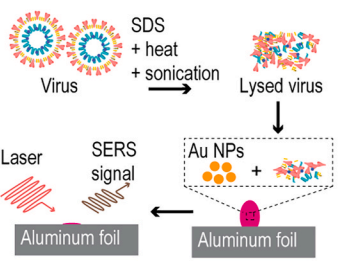THE CHALLENGE
The key challenge in developing effective virus detection tools for real-world environments lies in bridging the gap between laboratory-grade accuracy and field-ready usability. Current diagnostic methods like PCR and immunoassay are highly sensitive but depend on complex sample preparation, costly reagents, cold-chain logistics, and trained personnel, making them impractical for rapid, on-site deployment in places like airports, hospitals, or wastewater plants. Advanced techniques like Raman spectroscopy offer label-free detection and chemical specificity, but suffer from low sensitivity, interference from complex environmental media (like dust or aerosols), and technical hurdles such as inconsistent hotspot formation on nanoscale surfaces, which affects reproducibility and accuracy. These limitations create a clear market opportunity for a portable, easy-to-use, and cost-effective platform that combines the specificity of lab-based methods with the speed and simplicity needed for field use—offering real-time insights without sacrificing reliability or scalability.
OUR SOLUTION
We are developing a compact, portable virus detection platform designed for real-time environmental surveillance in high-risk settings like hospitals, airports, and public transit hubs. By combining a special low-background buffer with gentle heating and agitation, the system breaks open viral particles without the need for complex lab prep. It then uses gold or silver nanoparticles to concentrate viral components onto a tiny detection surface, where a Raman laser captures unique spectral fingerprints of the virus. Advanced machine learning instantly analyzes these fingerprints to identify and quantify threats like SARS-CoV-2, influenza, or other pathogens at very low concentrations. Unlike traditional diagnostics, our platform eliminates the need for molecular labels, cold-chain logistics, and lengthy protocols, making it ideal for continuous, on-site monitoring. This breakthrough offers businesses and public health agencies a fast, cost-effective, and scalable way to detect pathogens directly from air, surfaces, or wastewater—enabling earlier remediating interventions and reducing outbreak risks.

Figure: Schematic illustration of the key steps for SERS detection of lysed viruses
Advantages:
- Label-free, amplification-free detection
- High sensitivity in complex environmental matrices
- Real-time, on-site monitoring with portable lab-on-a-chip system
- Multiplexed virus identification using machine learning
Potential Application:
- Real-time airborne and surface virus monitoring in public spaces
- On-site viral detection in water and wastewater systems
- Inline viral contamination screening in biopharmaceutical manufacturing
- Field-deployable bio surveillance for biosecurity and defense